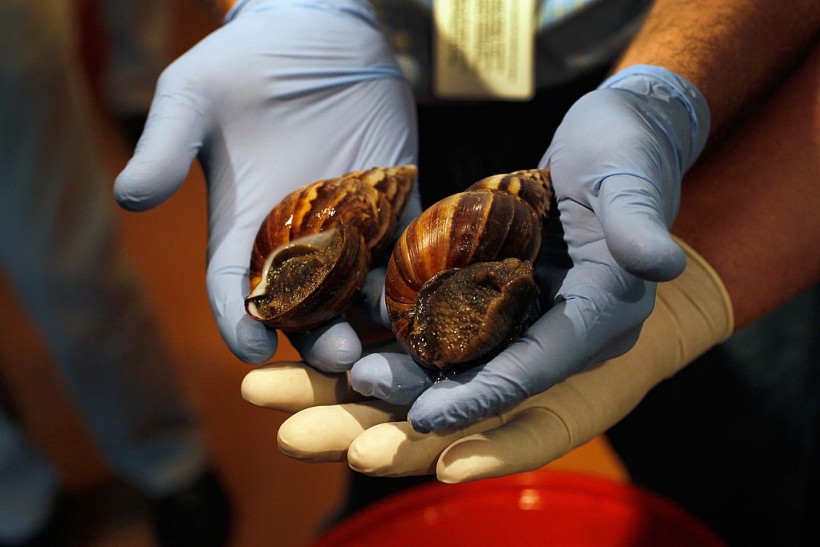An invasive species known as the giant African land snail is once again presenting a danger to the people of central Florida after being eliminated twice since the 1970s.
In the Pasco County neighborhood of New Port Richey, huge African land snails have been discovered. They are known to harbor the rat lungworm, a parasite that can cause meningitis.
Meningitis, which can be fatal, is an enlargement of the membranes protecting the brain and spinal cord, according to Today.

MIAMI, FL - SEPTEMBER 15: Giant African land snails are shown to the media as the Florida Department of Agriculture and Consumer Services announces it has positively identified a population of the invasive species in Miami-Dade county on September 15, 2011 in Miami, Florida. The Giant African land snail is one of the most damaging snails in the world because they consume at least 500 different types of plants, can cause structural damage to plaster and stucco, and can carry a parasitic nematode that can lead to meningitis in humans. An effort to eradicate the snails is being launched. The snail is one of the largest land snails in the world, growing up to eight inches in length and more than four inches in diameter.
Meningitis-Causing Snail Invades Florida
The Florida Department of Agriculture and Consumer Services (FDACS) reported on June 23 that the giant African land snail had made its home in Port Richey, a city located just north of Tampa.
The snail is also bad for the environment since it eats more than 500 different plants and destroys infrastructure because it loves to eat concrete.
A quarantine area was set at the beginning of the northwest juncture of U.S. Highway 19 and Ridge Road. Follow Ridge Road to the east, Little Road to the south, Trouble Creek Road to the west, and U.S. Highway 19 to the north.
Land snails were discovered in southern Florida for the first time in the 1960s, and it took over ten years and $1 million to eradicate them, according to the U.S. Department of Agriculture.
These snails lay 1,200 eggs every year, which is a high rate of reproduction. A single snail may lay thousands of eggs at once when it is four months old, and each one can develop into an adult that is 8 inches long, CBS News reported.
"Each snail contains both female and male reproductive organs," Daily Mail said, citing the United States Department of Agriculture.
State officials quarantined a section of Pasco County in the New Port Richey region this week to control them. For fear of the clinging mollusks spreading, no plants, yard garbage, rubbish, compost, or building materials may be legally transferred outside without authorization.
The quarantine may modify or expand if additional snails are discovered from a half-mile radius around the detected snail colony.
In a place where exotic species frequently cause havoc and where wildlife frequently makes news, the return of the snails was a surprise and undesirable occurrence. Late last year, a record-breaking 215-pound Burmese python was captured in the Everglades.
How Expensive Eradicating Such A Species Could Be
Bill Kern, an assistant professor at the University of Florida who specializes in nuisance wildlife management, told The New York Times that dealing with damaging invasive species and more than just a nuisance could be expensive.
For example, the West Indian drywood termite is the only insect that Floridians spend an estimated $100 million a year trying to eradicate.
Snail bait containing metaldehyde, a pesticide authorized for use in fruit trees, ornamental crops, and other plants, was applied to the quarantine area in Pasco County by the state on Wednesday. Metaldehyde disturbs the digestive tracts of huge African land snails and kills them.
The snails were previously eliminated from Florida twice: last year after they first showed up in Miami-Dade County in 2011, and in 1975 after they were discovered for the first time in the state in 1969.
A huge African land snail has not been spotted in Miami-Dade County since 2017, according to the agricultural department's announcement in 2021, which came after an eradication campaign in which more than 168,000 snails were gathered.
RELATED ARTICLE: Breakthrough Study Reveals How Meningitis Spreads Through Fungal Infection, Block and Damage Blood Vessels
Check out more news and information on Animals and Medicine and Health in Science Times.














